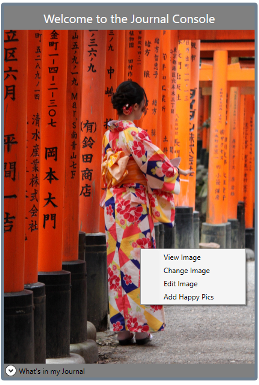Tile Stream
Episode 1: The Journal Console and a Revisit of Japan!
Journal Console opens with a randomly selected image. To start working with my images from my trip to Nepal, I open my Journal Console. This is the main interface for adding images and other types of entries to a personal copy of the integrated Journal.
The first thing that catches my eye is a picture selected by the system from the collections of images already in my Journal. And I like what I see! This is no surprise - to motivate me the system has shown it to me because I like it. How did it know? In the past when interacting with the system I indicated that I find the image beautiful, interesting and evocative … and that I don’t mind if other people see it. It was also chosen because I have not seen it for a while! This is all very motivating to me as I get ready to start working with more images! I wanna add more! And I want to see them come up in the console and other applications some time when I don’t expect it!
Design Principle: Interest, aesthetics, attention and cognitive ergonomics. The system seeks to find ways to stimulate my memory and my sense of aesthetics. And it does so by picking stimuli that are comfortable and motivating, depending on the task at hand and mood of the author. (How does it know ? More later!) On the other hand it should not ‘drive’ my attention: I can just ignore that image if I want to get on with things. Or can turn off the image part of the panel altogether. More later!
Design Principle: Surprise, replay-ability and pseudo random selection. Every use of the system should be uniquely stimulating; it should use the richness and number of my entries to produce novel and interesting experiences - this is how some aspects of human memory work and so a system used to work with memory should behave that way too. … more later!
For the moment, before I start adding images from Nepal, I feel like spending some more time with this image - and what it reminds me of. Since this is an integrated experience every image, every journal entry, every note, provides a window into the larger system (and even larger segments of my memory). So let’s see what this image, this window, opens up for me! As I hover the mouse over the image the system suggests some things.
View image: I can view the largest version of the image in higher resolution
Change image: I can tell the console replace this image with another - using the same selection parameters
Add Happy Pics: Atmosphere is important when working with memory! So the author can create sets of personalized selection parameters. I created “Happy Pics” to give me an emotional bump if I feel like I can use it during some sessions. In addition to pictures that I think are beautiful in some way, it will now mix in images with friends - smiling and laughing - and pictures that I think are funny. I even told it to include funny cartoons and jokes! Click here to see the first Happy Pic it picked for me! Go ->
What’s in My Journal: I don’t usually click this because I find it a little distracting. But sometimes I want to get an idea of what is in my personal journal. Let’s take a brief look at this and then get back to those kimonos in Japan!
Whaaaat!? 28 thousand entries!? I told you that I used this system myself!
15 thousand images! I am not kidding when I say that I think personal images are a big deal when capturing memory and experience.
The second largest set of entries is “General”: these include textual diary entries, notes and learning materials that I’ve made or captured. More on this in another series.
Topics: 10,000. “Topics” are ideas, concepts, terms, people, places, things. Each one of these can be related to any number of others by logic and semantic networks. This results in a big, evolving, interconnected tree of knowledge. Each author creates their own as they interact with the system (or doesn’t - if they are not into that). In this particular case the 10,000 topics are woven together with 27,000 logical relations. You will see what magic this creates later! (Preview: I can let the presentation system show me interactive movies, created by weaving together collections of images that it automatically gathers using AI driven analysis of my network of topics and themes … given a whole lifetime - movies generated will never repeat!)
The other Entry Types are optional. The author of the system can make up his/her own types (and the kinds of data that each might hold). But nothing is required - you can just use notes and pictures if you want.
Enough of this nerdy stuff! Back to beautiful things in Japan and then Nepal!
Edit Image: Did you notice that I skipped this option from the menu? I saved it for last - it positively explodes the number of ways that I can use this image to explore the contents of my journal and my memory - and that’s the point of all of this! So this is what I am going to select next in Episode 2: Surfing Japan. That kid getting her pic taken is going to be in it! Coming soon!



